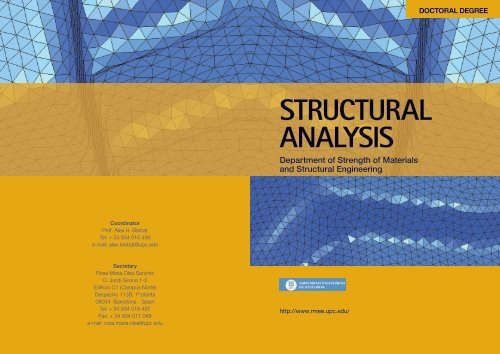structural analysis - Programa de Doctorat en Anàlisi Estructural - UPC
structural analysis - Programa de Doctorat en Anàlisi Estructural - UPC
structural analysis - Programa de Doctorat en Anàlisi Estructural - UPC
Create successful ePaper yourself
Turn your PDF publications into a flip-book with our unique Google optimized e-Paper software.
Coordinator<br />
Prof. Alex H. Barbat<br />
Tel: + 34 934 016 496<br />
e-mail: alex.barbat@upc.edu<br />
Secretary<br />
Rosa Maria Olea Sanchis<br />
C. Jordi Girona 1-3<br />
Edificio C1 (Campus Norte)<br />
Despacho 113B, 1ª planta<br />
08034 Barcelona - Spain<br />
Tel: + 34 934 016 497<br />
Fax: + 34 934 011 048<br />
e-mail: rosa.maria.olea@upc.edu<br />
STRUCTURAL<br />
ANALYSIS<br />
Departm<strong>en</strong>t of Str<strong>en</strong>gth of Materials<br />
and Structural Engineering<br />
Direcció <strong>de</strong> Comunicació. DL: B-XXXX-2009<br />
http://www.rmee.upc.edu/<br />
DOCTORAL DEGREE
Introduction<br />
The Doctoral Degree in Structural Analysis is taught at the<br />
Departm<strong>en</strong>t of Str<strong>en</strong>gth of Materials and Structural Engineering<br />
(RMEI) of the Universitat Politècnica <strong>de</strong> Catalunya, in collaboration<br />
with researchers<br />
from the International C<strong>en</strong>tre<br />
for Numerical Methods<br />
in Engineering. The Departm<strong>en</strong>t<br />
carries out research in<br />
computational mechanics.<br />
Stu<strong>de</strong>nts who <strong>en</strong>rol in the<br />
Degree are assigned to one<br />
of the Departm<strong>en</strong>t’s research<br />
lines.<br />
Aims and structure of the Degree<br />
The aim of the Doctoral Degree in Structural Analysis is to<br />
produce excell<strong>en</strong>t researchers in this broad field, which itself<br />
lies within the field continuum mechanics and the treatm<strong>en</strong>t<br />
of these problem using finite elem<strong>en</strong>t techniques. The Degree<br />
is divi<strong>de</strong>d into two basic areas:<br />
a) Methods. Stu<strong>de</strong>nts will become familiar with the following:<br />
- Numerical treatm<strong>en</strong>t of the most common <strong>structural</strong> systems:<br />
continua in 2 and 3 dim<strong>en</strong>sions, laminates, plates and beams.<br />
- Constitutive laws that <strong>de</strong>scribe the behaviour of materials<br />
to be analysed.<br />
- Numerical approaches to the differ<strong>en</strong>tial equations that<br />
govern <strong>structural</strong> behaviour.<br />
- Analysis of techniques for numerically solving the problems,<br />
which will inclu<strong>de</strong> coupling and interaction problems.<br />
b) Applications. Stu<strong>de</strong>nts should choose an area of specialisation<br />
that corresponds with the subject of their doctoral<br />
theses from the areas listed below:<br />
- Structural <strong>en</strong>gineering: numerical <strong>analysis</strong> of composite materials,<br />
seismic <strong>analysis</strong>, <strong>structural</strong> pathologies, experim<strong>en</strong>tal<br />
tests, monitoring of structures, etc.<br />
- Numerical simulation of processes: lamination, forging, solidification,<br />
mould filling, etc.<br />
- Parallelisation of computation.<br />
- Incorporation of new materials for <strong>structural</strong> applications:<br />
composites, fibres.<br />
- Experim<strong>en</strong>tal <strong>analysis</strong> of <strong>structural</strong> compon<strong>en</strong>ts.<br />
Research lines<br />
- Analysis of <strong>structural</strong> problems in continuum mechanics<br />
using advanced numerical methods.<br />
- Advanced <strong>structural</strong> <strong>analysis</strong> using experim<strong>en</strong>tal and numerical<br />
methods.<br />
- Study of str<strong>en</strong>gth<strong>en</strong>ing elem<strong>en</strong>ts and manufacturing processes<br />
using experim<strong>en</strong>tal and simulation techniques.<br />
- Structural <strong>analysis</strong> of composite materials.<br />
- Fluid-structure integration.<br />
- Earthquake <strong>en</strong>gineering and <strong>structural</strong> dynamics.<br />
- Calculations methods for estimating <strong>structural</strong> safety.<br />
- Constitutive laws of new materials.<br />
Research groups working on these lines<br />
- LITEM - Technological Innovation in Materials and Structures<br />
Laboratory<br />
- REMM - Research Group in Structures and Mechanics<br />
of Materials<br />
- (MC)2 - Computational Mechanics of Continuous Media<br />
Group<br />
- GIES - Geophysics and Earthquake Engineering<br />
- CIMNE - International C<strong>en</strong>tre for Numerical Methods<br />
in Engineering<br />
G<strong>en</strong>eral information<br />
50 available inscriptions per aca<strong>de</strong>mic year.<br />
Main <strong>en</strong>try requirem<strong>en</strong>ts<br />
A <strong>de</strong>gree in civil <strong>en</strong>gineering, industrial <strong>en</strong>gineering or architecture.<br />
Other aca<strong>de</strong>mic backgrounds wil be consi<strong>de</strong>red by the<br />
Doctoral Committee.<br />
Official master’s <strong>de</strong>grees that inclu<strong>de</strong> bridging<br />
courses for this programme<br />
- MASTER’S DEGREE IN STRUCTURAL AND CONSTRUCTI-<br />
ON ENGINEERING<br />
- MASTER’S DEGREE IN NUMERICAL METHODS IN EN-<br />
GINEERING<br />
Quality awards<br />
MCD2005-00341 (2005, 2006, 2007, 2008)<br />
Facilities and computer systems for stu<strong>de</strong>nts<br />
Laboratories<br />
- Elasticity and Str<strong>en</strong>gth of Materials Laboratory (LERMA)<br />
- Technological Innovation in Materials and Structures Laboratory<br />
(LITEM)<br />
Computer systems<br />
- Departm<strong>en</strong>t of Str<strong>en</strong>gth of Materials and Structural Engineering.<br />
- International C<strong>en</strong>tre for Numerical Methods in Engineering<br />
Professors of the Departm<strong>en</strong>t<br />
Carlos Agelet <strong>de</strong> Saracibar Bosch<br />
Santiago I. Badia Rodriguez<br />
Alex H. Barbat<br />
Gabriel Bugeda Castelltort<br />
Juan Carlos Cante Teran<br />
Miquel Casafont Ribera<br />
Miguel Cervera Ruiz<br />
Michele Chium<strong>en</strong>ti<br />
Ramon Codina Rovira<br />
Daniel Di Capua<br />
Miquel Ferrer Ballester<br />
Lluis Gil Espert<br />
Alfredo Edmundo Huespe<br />
Fre<strong>de</strong>ric Marimon Carvajal<br />
Juan Miquel Canet<br />
Xavier Oliver Olivella<br />
Sergio Horacio Oller Martinez<br />
Eug<strong>en</strong>io Oñate Ibañez <strong>de</strong> Navarra<br />
M. Magdal<strong>en</strong>a Pastor Artigues<br />
Riccardo Rossi<br />
Francesc Roure Fernan<strong>de</strong>z<br />
Montserrat Sanchez Romero<br />
B<strong>en</strong>jamin Suarez Arroyo<br />
Jose Francisco Zarate Araiza<br />
Other professors<br />
R. L. Taylor (University of Berkeley, USA)<br />
S. I<strong>de</strong>lsohn (Univerisidad <strong>de</strong> Rosario, ARGENTINA)<br />
R. Löhner (Univeristy of Wanshington, USA)<br />
F. Flores (Universidad Nacional <strong>de</strong> Córdoba, ARGENTINA)<br />
C. Felippa (University of Colorado at Boul<strong>de</strong>r USA)<br />
J. Rojek (Institute of Fundam<strong>en</strong>tal Technological Research.<br />
Aca<strong>de</strong>my of Sci<strong>en</strong>ces (POLONIA)


